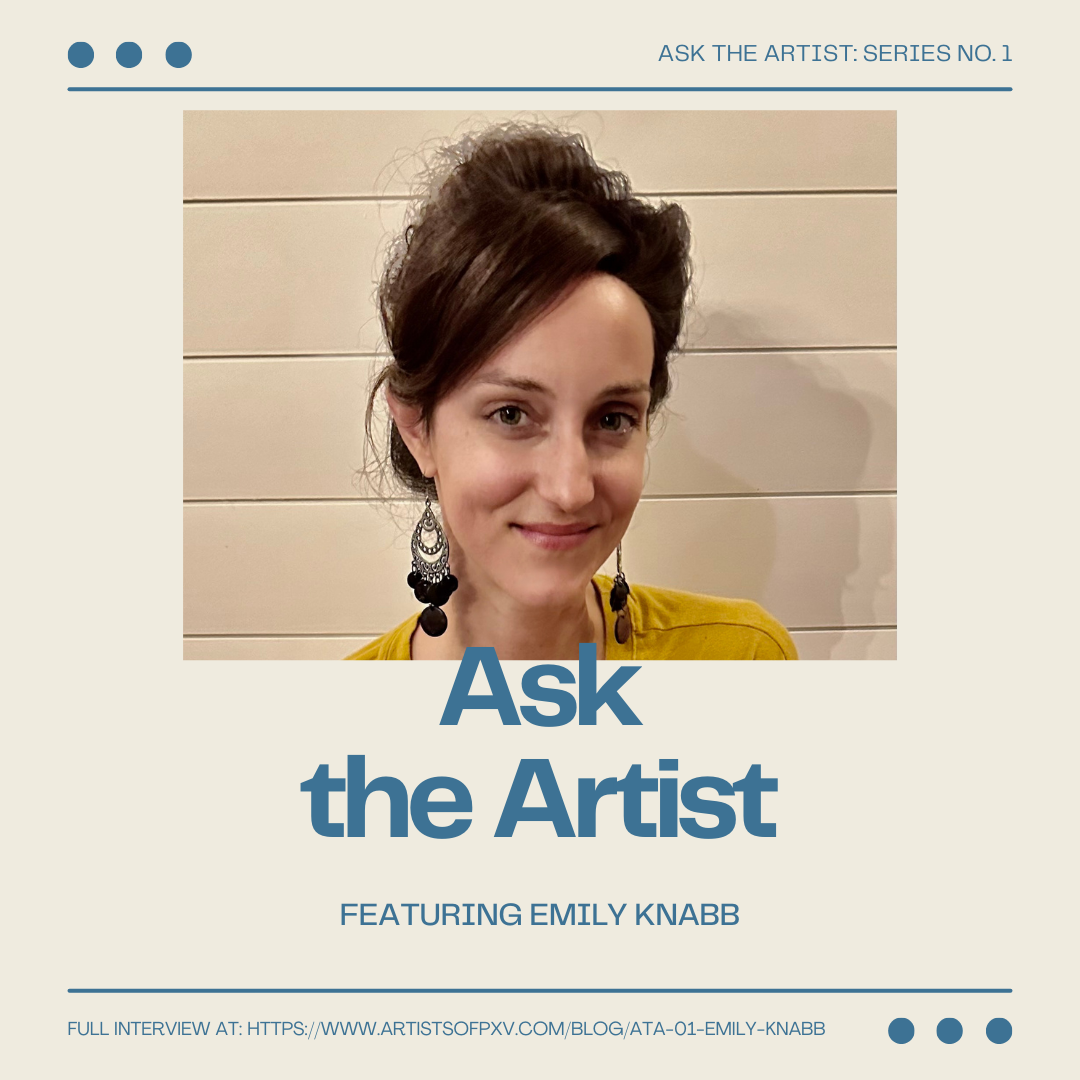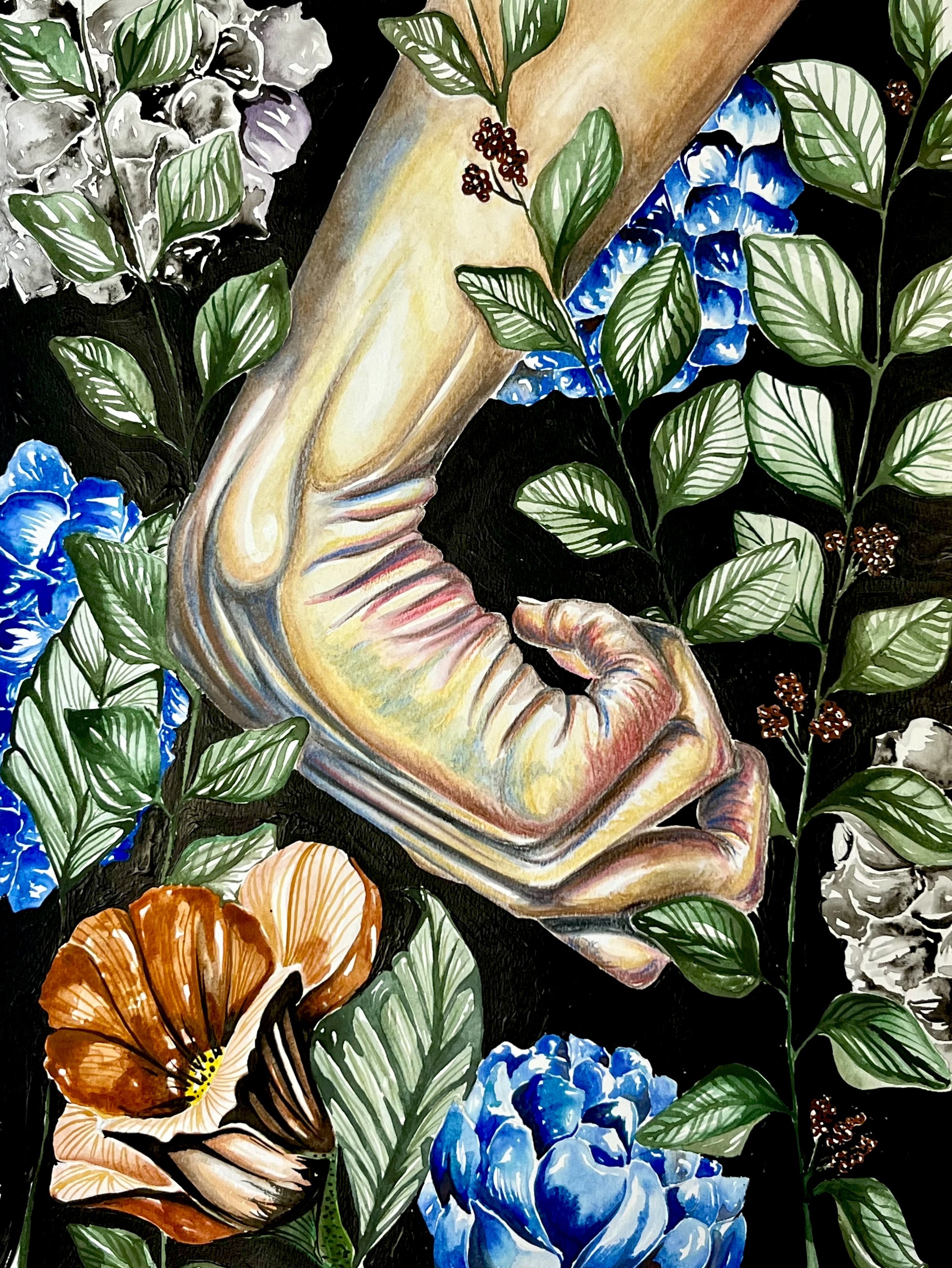Ask the Artist Series No. 01: Emily Knabb
Ask the Artist is a Q&A blog series where Sarah Jackson interviews artists about the work they do, their creative process, and the joys and struggles they face as an artist and a person. Each blog post focuses on a single artist in the Phoenixville art community.
Art and movement have always been intertwined in Emily Knabb’s creative practices. She’s earned multiple degrees, including Art Education, was a dancer for many years, and has even taught fitness classes. Though her chronic health conditions have sidelined some of her more active pursuits, movement has remained a through line in her art. With pastel, charcoal, and watercolor, Emily illustrates human hands to explore her relationship with chronic pain, the nature of healing, and connection with the world around her.
Check out the Q&A below to discover the challenges Emily faces as an artist, what she’d tell her past self, and the work she’s most proud of.
Sarah: Where do you draw inspiration for your work?
Emily: I have multiple autoimmune illnesses, which is the meaning behind a lot of my work. And over the last 10 years, what keeps coming up are hands. When I'm having a flare or suffering through something hard, my hands are what care for me. I'm not looking in the mirror. I’m watching my hands struggle through it. They have their own injuries in and of themselves but still push through the daily tasks that need to be done. My hands have been the conduit to narrating the healing of my mind, body, and spirit. As a teacher, I don’t talk about my personal stuff a lot in public—I guess it’s a way to make others feel more comfortable. But when I was working with Teresa Hagg, a local artist and art coach, she gave me that permission to tell the truth for myself and that I was allowed to talk about my body.
S: What’s one challenge you face as an artist?
E: I’m not a businesswoman yet, and I've never had a business class in my whole life. So, it's difficult figuring out that process and learning how to be an entrepreneur and how to organize. But you could say that with anything, like meal prep or movement or sleep or family. We are what we prioritize, and that will always change with the seasons of our lives. But for me right now, it really comes down to learning how to sell my stuff and going to art shows. It's hard as shit, but I'm having so much fun. For these long art shows, we get up at 4 or 5 a.m., we build a store on the street, and then we sell all day and clean it up and go home. At first, I thought, ‘This is either going to make or break me. I don't know if I can physically do this.’ But it's almost been part of my medicine. It’s been building me up. I'm sure every show won't be amazing that way, but I did my first three outdoor shows last summer and they went really well.
S: What’s a rewarding part of being an artist?
E: This healing pilgrimage that I'm on, I felt like it was this deep, dark secret that no one ever wants to talk with me about. I had to kind of push everyone away to get to what I call this cocoon phase of healing. I had to say no to things for years, and that breaks my heart, but I also needed to be alone to figure it out. So, what's rewarding about this now is that I'm talking about it, and I'm healing every time I talk about it. I'm opening my story for people to maybe understand me a little better, and that makes me feel more welcome, because I just felt like it was all a secret, and I hated that. My art has been so rewarding because when people come into my art booth at shows, we're talking about love, loss, death, fantasy, dreams, and struggle. And at the end of that conversation, we're celebrating that we're still here and that we have those connections.
S: What do you hope people will notice or take away from your work?
E: One of my favorite words, actually, is sonder, which is realizing that every other human has a world that's complex and interesting, with other people's connections and hopes and dreams and histories and traumas all at the same time. How small does that make our egos, in a healthy way? Because it's not all about me, and it's going to be okay. I think the healing pilgrimage can make me think, ‘You're the worst. You're broken. You're a mistake. Everyone else is fine. Look at them.’ But this work makes me feel less alone. I make my art for an audience of one—myself. And I make it to help myself feel less alone. So if my art could talk, I would want it to let others know that they are not alone, too.
S: Is there a piece or collection you’re most proud of?
E: I have my first solo art show going on right now (March 2024) that I’m really excited about! It features 20 original artworks in my Healing Hands Collection, plus my first-time ever limited-edition art prints and greeting card sets. Leading up to the show, I made a group of work called The Permission Series, a seven-piece art series that reminds me to give myself permission in all the ways I need to learn how. Permission to rest, shine, indulge, desire, hope, savor, and rage. It connects my physical and mental health as I evolve into the woman I really want to be.
S: Do you have any advice for your past self?
E: I don't even know if I gave myself permission to call myself an artist, which is such a sad thing. I always thought an artist had to look a certain way and be a certain way. So, I was dipping my toe in yoga and poetry and dance, so I thought, ‘Oh, well, I'm not a real artist.’ But since I've realized, ‘I am, though, and that's okay,’ it's felt so good. So, I would tell my past self to just keep going. Just keep going. I have stopped and started and reversed so many art projects before starting my art business because I thought they weren’t ‘good enough.’ I didn’t think I had the skills to do it. So, just keep going, and figure out each step of the way little by little.
S: How do you protect your energy as an artist?
E: Energy is an elusive topic for someone with multiple autoimmune diseases. There was a time when I intentionally limited my thoughts and actions just to have enough steam to make it to lunchtime! In the darkness of chronic pain and working through solutions to fight for a stable life, I began guided meditations by Tara Brach (a psychologist, author, and teacher of meditation, emotional healing and spiritual awakening.) I sat with discomfort and somehow fell back in love with myself when I began accepting my reality. Over many months and years, my strength increased and my daily meditations became a choice and not a chore. On the days I make art, I've noticed I don't need a meditation session. Art = Energy. Now I use other energy-protecting modalities such as hot yoga and cooking. With these grounded practices placed strategically in my week, I can care for my creative and physical energy the most. What I appreciate about stumbling through this healing life, is that I now have many tools to fall back on in times of need.
You can find Emily’s work at her solo show, Healing Hands, at the Jeweled Warrior through the end of March in person or online here.
Check out her Instagram @emilyknabbart or her website: emilyknabbart.com
She is currently filling her calendar with outdoor art festivals to share her work and meet like-minded health seekers. The full schedule will be posted and updated at https://emilyknabbart.squarespace.com/upcomingevents
March 2024 – Solo Art Exhibit at The Jeweled Warrior
April 21, 2024 – Abington Art Center Spring Art & Fine Craft Fair 2024
June 1, 2024 – Moravian Historical Society 46th Annual Arts & Crafts Festival
June 8, 2024 – Chester County Pride Fest
June 15, 2024 – PXV Street Art Festival
September 14-15/24 – Rose Squared Ludwig’s Corner
This interview was conducted by Phoenixville-based writer and editor Sarah Jackson. Visit Sarah’s website to learn more about her work and how to get connected.




